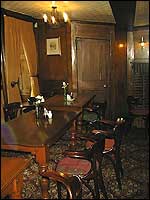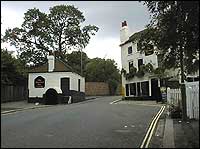Spaniard's Inn, Hampstead, London
Created | Updated Feb 25, 2007

Spaniard's Inn is one of those great drinking establishments that can be found throughout the English countryside, offering the very best in beer, real ale and great pub grub. What makes Spaniard's Inn different is its fascinating history and the fact that it is located within a 15-minute walk of Hampstead High Street - one of London's most popular shopping areas.
The Inn is on Spaniard's Road, the thoroughfare which bisects north London's Hampstead Heath. The easiest way to get there is by car, but this means that you won't be able to taste the ale and drive as well. Also, the road bottlenecks at Spaniard's Inn which means that only one car can pass at a time - a fact which often leads to a few minutes' wait.
There are two ways to get to the pub. Firstly, you can wait for a number 210 bus, which is never very reliable but will drop you off right outside the Inn's door. This route does not have a night service so it's always best to order a cab for the journey home. Alternatively, you can always take the Northern Line on the London Underground to Hampstead station. Take a right out of the station and head up the hill past Pizza Express and the Victorian church selling second-hand books. As you get to the top of the hill, you will see Jack Straw's Castle on your left and a fork in the road with a war memorial at its point. Take the right fork (this is Spaniard's Road), and walk for 15 minutes and you'll see Spaniard's Inn on the left.
The History

The Inn was built around 1585 and gets its name either from the fact that it was the country retreat of the Spanish Ambassador to James I of England and VI of Scotland, or it was named after a Spanish landlord, Francis Porrero.
Legend has it that the highwayman Dick Turpin was born here on 21 September, 1705. This may or may not be true, but what is known is that his father was a landlord of the Inn during the 18th Century. It's a great romantic notion to think that the mighty Dick Turpin used to watch the horse and carts loaded with the gentry rolling past his window, giving him the inspiration to lead his life of crime. Romantic, but more than likely complete tosh.
The Inn also played a vital role in saving the life of one Lord Mansfield. In 1780, Lord Gordon (a rampant Protestant) led a group of hoodlums to attack Lord Mansfield (pro-Catholic) at Kenwood House, his home. They would have succeeded had they not stopped at the Inn to quench their thirst. The landlord, Giles Thomas, alerted the army. After an initial skirmish with the army, the surviving members of Lord Gordon's gang surrendered, were taken to Newgate prison and promptly hanged.
The pub also has a great literary heritage. Not only has it been mentioned in Dickens's The Pickwick Papers and Bram Stoker's Dracula, but it can count among its previous frequenters the artist Joshua Reynolds and the poets Byron and Keats. If you believe the Inn's spiel, Keats allegedly wrote his Ode to a Nightingale in the gardens.
All this information is plastered on chalkboards around the bar and garden.
In the pub's more recent history, those of you who have been there may remember the three-legged cat. This beloved moggy was a fixture of the pub for over a decade (a remarkable feat considering the volume of traffic in the area) but sadly died at the beginning of the Millennium. He is sorely missed by the landlord and locals alike.
The Layout

The Inn is actually in two parts. The larger half is the pub area and the smaller outhouse on the other side of the road is the old horse trough/watering hole. This small building is the cause of the bottleneck mentioned above. The pub and watering hole are Grade II listed buildings - this basically means that they cannot be knocked down or redeveloped without a very good reason - and cannot be touched, much to the chagrin of the residents.
The pub itself is actually quite small; there is a food room where you can choose from some rather good traditional British pub grub like sausages with mash and onion gravy, steak and ale pie and ploughman's lunch. Before you get to the main bar there is a room with sumptuous leather banks and polished tables highly conducive for a group of ten. The main bar sports all the usual tat associated with traditional English pubs including copperware, reproduction prints and jugs.
The greatest room in the pub is Turpin's Room which legend says was the infamous highwayman's childhood room. The floor is uneven and the windows look out on to the road and the heath. The great thing about the room is the roaring fire and the sense of homeliness that it inspires. This room is where you'll find all the pub games such as dominoes, Trivial Pursuit and decks of cards.
Most people head for the pub's beer garden which has modern sculptures and shrubbery at its centre. This is where you'll find water bowls for dogs. There's an aviary which houses a few budgies and canaries who are, for the most part, friendly. This is enough to keep children occupied for a few minutes.
The pub is phenomenally busy at weekends, insufferably crowded during the summer but worth a visit nonetheless. The best time to visit is in the winter; get there early, snuggle up on one of the exceptionally comfy chairs, kick your shoes off and settle in for the evening. You can always catch a cab home.

